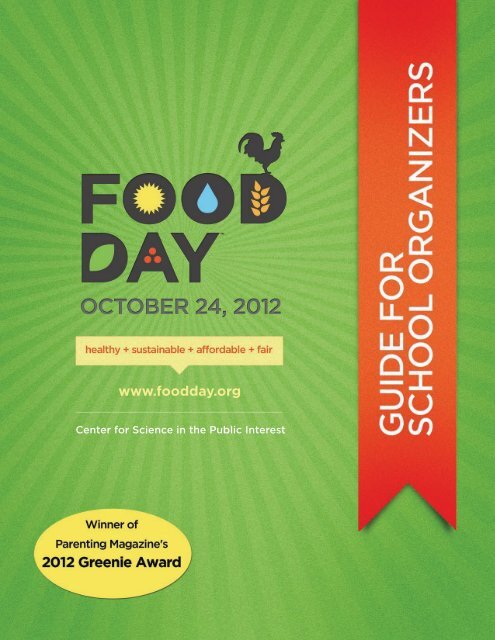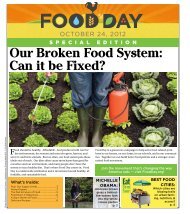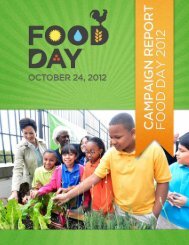Guide for Schools - Food Day
Guide for Schools - Food Day
Guide for Schools - Food Day
Create successful ePaper yourself
Turn your PDF publications into a flip-book with our unique Google optimized e-Paper software.
www.foodday.org<br />
Center <strong>for</strong> Science in the Public Interest
2<br />
healthy + sustainable + af<strong>for</strong>dable + fair<br />
Dear <strong>Food</strong> <strong>Day</strong> Leader,<br />
<strong>Food</strong> <strong>Day</strong> is a nationwide celebration and movement toward<br />
more healthy, af<strong>for</strong>dable, and sustainable food that takes<br />
place annually on October 24. In 2011, the inaugural <strong>Food</strong><br />
<strong>Day</strong> was celebrated with more than 2,300 events in all<br />
50 states. Many major school districts—and many more<br />
individual classrooms—got involved, including Boston, Los<br />
Angeles, Boulder County (CO), Portland (OR), and more.<br />
Please help make <strong>Food</strong> <strong>Day</strong> 2012 an even bigger success!<br />
With sky-high rates of childhood obesity—at the same time<br />
that millions of children have limited access to healthy, fresh<br />
food—the <strong>Food</strong> <strong>Day</strong> ef<strong>for</strong>t is especially relevant to children<br />
and schools. <strong>Food</strong> <strong>Day</strong>’s supporters include the National<br />
Education Association’s Health In<strong>for</strong>mation Network,<br />
National Assembly on School-Based Health Care, several<br />
state education departments, and numerous school districts.<br />
This year, <strong>Food</strong> <strong>Day</strong> is partnering with the President’s<br />
Challenge Program to help encourage families and children<br />
to develop healthy lifestyles and support First Lady Michelle<br />
Obama’s Let’s Move! initiative to end childhood obesity<br />
within a generation.<br />
This guide will provide you with the tools you need <strong>for</strong><br />
organizing successful <strong>Food</strong> <strong>Day</strong> activities in your school’s<br />
classrooms, lunchroom, or garden, and tips on improving<br />
school food policies. When considering how to incorporate<br />
<strong>Food</strong> <strong>Day</strong> activities into schools, remember to invite the<br />
entire system to get involved—from administrators and<br />
teachers to school nutrition services directors and physical<br />
education specialists—and don’t <strong>for</strong>get students! By working<br />
together, you can become one strong, united voice educating<br />
and involving students and advocating <strong>for</strong> change.<br />
To get inspired by last year’s <strong>Food</strong> <strong>Day</strong>, check out the 2011<br />
report with highlights of what happened around the country,<br />
and watch our video about the ways people across the country<br />
celebrated <strong>Food</strong> <strong>Day</strong>.<br />
<strong>Food</strong> <strong>Day</strong> is your day, and it will be as successful as you make<br />
it. Please contact us <strong>for</strong> assistance as you develop your plans:<br />
foodday@cspinet.org or 202-777-8392.<br />
Good luck and thanks <strong>for</strong> joining us!<br />
The <strong>Food</strong> <strong>Day</strong> Team<br />
Center <strong>for</strong> Science in the Public Interest<br />
1220 L St. NW, Suite 300<br />
Washington, DC 20005<br />
foodday@cspinet.org<br />
202-777-8392
GUIDE FOR<br />
SCHOOL ORGANIZERS<br />
TABLE OF CONTENTS<br />
<strong>Food</strong> <strong>Day</strong> priorities ........................................................ 4<br />
<strong>Food</strong> <strong>Day</strong> 2011 in schools .............................................. 4<br />
School curriculum .......................................................... 6<br />
<strong>Food</strong> <strong>Day</strong> in the cafeteria ............................................... 8<br />
Healthy school meal standards ....................................... 9<br />
<strong>Food</strong> <strong>Day</strong> in the school garden ..................................... 12<br />
Sample letter to the school board ..................................14<br />
Register your event ........................................................15<br />
OUR VISION<br />
<strong>Food</strong> <strong>Day</strong> is a nationwide celebration and movement toward<br />
more healthy, af<strong>for</strong>dable, and sustainable food. <strong>Food</strong> <strong>Day</strong> was<br />
created by the nonprofit Center <strong>for</strong> Science in the Public Interest<br />
(CSPI). More than 100 national groups and 80+ Advisory Board<br />
members help raise awareness of food issues and strengthen the<br />
food movement. With <strong>Food</strong> <strong>Day</strong>, we can celebrate what we have<br />
and join our <strong>for</strong>ces to achieve what we need<br />
<strong>Food</strong> <strong>Day</strong> is not just a day; it’s a catalyst <strong>for</strong> healthier diets<br />
and a better food system. Let’s use all this energy to make a<br />
meaningful and long-lasting difference!<br />
3
4<br />
FOOD DAY PRIORITIES<br />
<strong>Food</strong> <strong>Day</strong> is: Healthy + Sustainable + Af<strong>for</strong>dable + Fair<br />
Our national priorities address overarching concerns within the food system and give<br />
common ground <strong>for</strong> building the movement. We intentionally keep our plat<strong>for</strong>m broad<br />
and cultivate <strong>Food</strong> <strong>Day</strong> in order to:<br />
Promote safer, healthier diets<br />
Support sustainable and organic farms<br />
Reduce hunger<br />
Re<strong>for</strong>m factory farms to protect the environment and animals<br />
Support fair working conditions <strong>for</strong> food and farm workers<br />
<strong>Schools</strong> are ideal places <strong>for</strong> food education, as<br />
making healthy choices has gotten more difficult,<br />
and our children are especially vulnerable to<br />
junk-food marketing and poor food choices.<br />
Healthy and appropriate eating habits in children<br />
will impact their weight and health as adults.<br />
In addition, balanced and healthy school meals<br />
improve school per<strong>for</strong>mance and behavior.<br />
We hope that <strong>Food</strong> <strong>Day</strong> will inspire actions to<br />
advocate <strong>for</strong> local, state, and federal policies and<br />
programs that promote healthy eating and obesity<br />
prevention among children and youth.<br />
FOOD DAY 2011 IN SCHOOLS<br />
Hundreds of schools participated in <strong>Food</strong> <strong>Day</strong><br />
activities in 2011 in ways that included taste tests<br />
introducing children to new, healthy options;<br />
nutrition lessons; cooking demonstrations;<br />
lectures; workshops; conferences; and health fairs.<br />
Special <strong>Food</strong> <strong>Day</strong> menus were served in Detroit,<br />
Denver, Boston, Portland, and Boulder County<br />
public schools. Here are some events from around<br />
the country:<br />
Halls of Shame<br />
Bentonville, Arkansas<br />
Students at nine public schools created “Junk<br />
<strong>Food</strong> Halls of Shame” collages to highlight<br />
marketing of junk to children and held a contest<br />
to increase the number of students eating a<br />
healthy lunch at their school. The prize was a<br />
healthy meal prepared by a professional chef.
Rabbit Creek Elementary<br />
Anchorage, Alaska<br />
Students at Rabbit Creek School in South Anchorage participated in a blind taste test<br />
comparing locally grown carrots to out-of-state carrots. They judged the Alaskan carrots<br />
to be superior by a two-to-one margin.<br />
School Menu Trans<strong>for</strong>mation Initiative<br />
Los Angeles, Cali<strong>for</strong>nia<br />
Jonathan Fielding, the Director of Los Angeles County Department of Public Health,<br />
along with Chef Giovanni Delrosario of Chefs Move to <strong>Schools</strong> (a program of Let’s<br />
Move!), visited elementary schools in the Los Angeles Unified School District to talk to<br />
children about the importance of eating a healthy breakfast. Cooking demonstrations<br />
showcased the school-menu-trans<strong>for</strong>mation initiative aimed to emphasize more healthy<br />
and sustainable foods <strong>for</strong> students.<br />
Encouraging “Smart Choices” on <strong>Food</strong> <strong>Day</strong><br />
Boston, Massachusetts<br />
Boston Public <strong>Schools</strong> <strong>Food</strong> and Nutrition Services served a special local menu on<br />
October 24 featuring locally grown apples, butternut squash, and green beans as part of<br />
a healthy meal of baked pollock with lemon-butter, paprika, and parsley. The Health and<br />
Wellness Department sent <strong>Food</strong> <strong>Day</strong> posters to all school principals to publicize the day<br />
and made available a special “Smart Choices” toolkit with strategies and educational tools<br />
<strong>for</strong> healthy eating.<br />
Students Talk Policy<br />
Raleigh, North Carolina<br />
Nearly 200 community repre sentatives from across North Carolina, including students<br />
from Raleigh’s Exploris Middle School, met <strong>for</strong> a conference at the State Legislative<br />
Build ing to discuss ways to increase access to, and consumption of healthy, local fruits<br />
and veg etables. Participants collected over 1,000 pounds of fresh fruits and vegetables to<br />
donate to food-insecure families.<br />
Presidential Active Lifestyle Award (PALA+)<br />
This year <strong>Food</strong> <strong>Day</strong> is partnering with the President’s Challenge Program<br />
to ask Americans to get active, eat real every day, and help encourage<br />
families and children to develop healthy lifestyles. To support First Lady<br />
Michelle Obama’s Let’s Move! initiative to end childhood obesity within a<br />
generation, PALA+ calls <strong>for</strong> a weekly healthy eating goal and 60 minutes<br />
per day of physical activity <strong>for</strong> kids and 30 minutes per day <strong>for</strong> adults,<br />
five days a week <strong>for</strong> six out of eight weeks. Help us promote the Challenge<br />
(www.presidentschallenge.org) in the weeks leading up to <strong>Food</strong> <strong>Day</strong>.<br />
5
6<br />
SCHOOL CURRICULUM<br />
Professors at Teachers College, Columbia University,<br />
created a unique <strong>Food</strong> <strong>Day</strong> school curriculum. The 88page<br />
<strong>Food</strong> <strong>Day</strong> curriculum <strong>for</strong> upper elementary and<br />
middle school grads offers five lessons designed to teach<br />
children the importance of eating real, fresh food; cutting<br />
back on processed foods; and advocating <strong>for</strong> a healthier<br />
community. The lessons can be easily adapted <strong>for</strong> older<br />
or younger students. Teachers are encouraged to use the<br />
curriculum on the week of October 24. You can download<br />
the curriculum <strong>for</strong> free at www.foodday.org.<br />
“I cannot say enough about this amazing series! The <strong>Food</strong> <strong>Day</strong><br />
curriculum really sparked engagement in my students. I have seen<br />
many students who are typically bored and under-stimulated,<br />
trans<strong>for</strong>m into engaged, participatory, and enthusiastic students<br />
when I use this curriculum. It’s so visual and user-friendly.”<br />
— Jessica Zirn, nutrition educator, who taught the<br />
curriculum to students in Madison, Wisconsin<br />
The students make Eat Real Action Plans and learn to compare whole and processed<br />
foods, choose a more plant-based diet, and reduce the portions of foods with excess sugar,<br />
salt, and unhealthy fats. In an interactive way, they master how to use USDA’s My Plate<br />
when planning their meals. They learn about challenges to “Eating Real” and create an<br />
advocacy project to make it easier <strong>for</strong> their community to “Eat Real.”<br />
Although the five lessons have been designed to be taught in sequence around the time<br />
of <strong>Food</strong> <strong>Day</strong>, you can use them individually and at any time. We highly encourage you<br />
to teach the lessons the week of October 24th! Imagine the impact we can have if schools<br />
across the country teach the lessons at the same time and advocate within their districts<br />
<strong>for</strong> positive change. You will find the instructions in the curriculum <strong>for</strong> connecting<br />
the lessons to Common Core State Standards and to Science Education Standards<br />
<strong>for</strong> students.
“The <strong>Food</strong> <strong>Day</strong> cur riculum is powerful in its simplicity. It provides<br />
tools that teachers can use to promote <strong>Food</strong> <strong>Day</strong> goals throughout<br />
the school year.”<br />
The following is a sampling of other suggested <strong>Food</strong> <strong>Day</strong> activities in schools. Many of<br />
the activities can be adapted to any educational level or situation. Be creative!<br />
Have a healthy-food<br />
drawing competition or<br />
create a class mural of<br />
students’ favorite fruits<br />
and vegetables. Follow<br />
up with a discussion of<br />
why eating fruits and<br />
vegetables is healthier.<br />
Build a “Junk <strong>Food</strong> Hall<br />
of Shame” and “Super<br />
<strong>Food</strong> Hall of Fame.”<br />
Have students cut out<br />
junk-food advertisements<br />
in magazines or bring<br />
in food packages, and<br />
display items.<br />
Host a classroom tasting<br />
of farm- or garden-fresh<br />
fruits, veggies, and herbs.<br />
Have a grade-wide or<br />
school-wide super-food<br />
or junk-food drawing/<br />
coloring competition <strong>for</strong><br />
healthy snack prizes.<br />
Have a classroom poster<br />
or essay contest about<br />
food and farms.<br />
— Chef Tim Cipriano, New Haven Public <strong>Schools</strong>,<br />
New Haven, Connecticut<br />
Take a field trip to a<br />
farm, pumpkin patch, or<br />
apple orchard.<br />
Have a school-wide<br />
assembly and invite<br />
farmers and/or<br />
chefs to talk and do<br />
demonstrations.<br />
Organize a petition to<br />
remove any junk food<br />
and soda from vending<br />
machines.<br />
Host a cooking<br />
competition involving<br />
local chefs and student<br />
helpers.<br />
Take a field trip to get<br />
hands-on experience<br />
at an urban garden or<br />
local health-oriented<br />
restaurant.<br />
Evaluate the de facto<br />
nutrition policy of<br />
the individual school<br />
or school district<br />
and petition <strong>for</strong><br />
improvements.<br />
Organize a debate about<br />
food, agriculture, or the<br />
environment, either in<br />
the classroom or in an<br />
assembly.<br />
Coordinate a research<br />
project <strong>for</strong> students<br />
around food, agriculture,<br />
or biology on or around<br />
<strong>Food</strong> <strong>Day</strong>.<br />
Coordinate with other<br />
subject areas (health, PE,<br />
science, English, other<br />
classes) <strong>for</strong> integrated<br />
lessons and projects<br />
(e.g., essay competitions<br />
about science topics,<br />
guest speakers, etc.).<br />
Show a film to your<br />
students and have a<br />
discussion afterwards.<br />
Check out the<br />
Resources section of<br />
www.foodday.org <strong>for</strong> a<br />
Film Screening <strong>Guide</strong>.<br />
7
8<br />
FOOD DAY IN THE CAFETERIA<br />
“The best part about <strong>Food</strong> <strong>Day</strong> was having a na tional campaign to<br />
tie into. It was challenging to con vince the school food-service<br />
direc tors to prepare a locally sourced meal, but when they got the<br />
<strong>Food</strong> <strong>Day</strong> materials and the fancy poster, it made it click <strong>for</strong> them…”<br />
— Lindsay Howard,<br />
Montana <strong>Food</strong> Corps<br />
With schools implementing new school meal standards this fall, <strong>Food</strong> <strong>Day</strong> is a perfect<br />
tie-in to highlight successes and support the work toward healthier school food options. Use<br />
the momentum to improve school meals and help schools meet the new USDA standards.<br />
Some ways to celebrate <strong>Food</strong> <strong>Day</strong> in the cafeteria are:<br />
Serve a special cafeteria<br />
meal featuring local<br />
foods.<br />
Celebrate with local/<br />
seasonal produce.<br />
Introduce taste and food<br />
education activities in<br />
the cafeteria.<br />
Organize cooking<br />
demonstrations and<br />
recipe swaps.<br />
Use the day to expand a<br />
salad bar. Check out the<br />
Let’s Move Salad Bars to<br />
<strong>Schools</strong> program (www.<br />
saladbars2schools.org)<br />
Start a Farm to<br />
School program<br />
(www.farmtoschool.org).<br />
National Farm to School Network (NFSN) connects schools and local<br />
farms with the objectives of serving healthy meals in school cafeterias;<br />
improving student nutrition; providing agriculture, health, and nutrition<br />
education opportunities; supporting local and regional food systems. <strong>Food</strong><br />
<strong>Day</strong> and NFSN partner again this October <strong>for</strong> the second annual National<br />
Farm to School Month, and you can join a variety of exciting activities,<br />
including:<br />
• “Farm to School Counts,” a campaign <strong>for</strong> schools, school districts,<br />
and Farm to School practitioners to track the dollar value of<br />
local foods served and the number of children participating in<br />
educational activities during the month of October.<br />
• A “Theme of the <strong>Day</strong>” social media campaign spotlighting an aspect<br />
of Farm to School, activity, or food on each week day during the<br />
month.<br />
Connect with one of NFSN’s 8 Regional Lead Agencies or 50 State Leads<br />
on www.farmtoschool.org, and join in celebrating National Farm to School<br />
Month on www.farmtoschoolmonth.org.
HEALTHY SCHOOL MEAL STANDARDS<br />
Healthy, Hunger Free Kids Act<br />
In 2010, Congress passed the Healthy, Hunger Free Kids Act (HHFKA),<br />
which represents a major step <strong>for</strong>ward in providing all children with healthy<br />
school meals. More than 31 million children participate in the National<br />
School Lunch Program, and children consume a third to a half of their<br />
daily calories at schools. With one out of every three children in America<br />
overweight or obese, we should ensure that school foods are healthy.<br />
As part of the HHFKA, the USDA recently updated the nutrition standards<br />
<strong>for</strong> school meals. The new standards will:<br />
• Double fruit and vegetable servings and increase the variety of<br />
vegetables.<br />
• Set first-ever standards <strong>for</strong> sodium, trans-fat, and whole grains.<br />
• Require all the milk to be low-fat or fat-free.<br />
• Set calorie standards that address not only hunger but also obesity.<br />
Healthy School Meals, Snacks, and Beverages<br />
<strong>Schools</strong> will begin implementing these new standards this school year! Here are some<br />
ways you can help support implementation of these healthy school meal standards.<br />
Encourage Students to Eat Healthy School <strong>Food</strong>s<br />
Work with your school district and school to:<br />
Get students involved — taste tests, voting on meal options, recipe contests, a student<br />
ambassador who strategizes how to get peers involved and excited about school meals,<br />
etc.<br />
Work with teachers — offer taste tests so teachers are more familiar with new school<br />
offerings and talk about them with students, encourage teachers to eat school lunch<br />
with students, conduct teacher training on nutrition education and the benefits of the<br />
new school nutrition standards, etc.<br />
Send in<strong>for</strong>mation home to parents — invite parents to eat lunch at school, send a letter<br />
or include a message in the school newsletter about the improvements to school meals<br />
and how parents can rein<strong>for</strong>ce healthy eating at home, have taste tests and a school<br />
food booth at parent nights, and encourage parents to participate on a school wellness<br />
policy or health committee.<br />
9
10<br />
Implement a policy to require that recess be held be<strong>for</strong>e lunch, which helps children eat<br />
better and be more ready to learn when they return to the classroom.<br />
Increase meal appeal — cook vegetables to preserve vibrant color; vary the cuts of<br />
fruits, vegetables, sandwiches; use catchy names like zippin’ zucchini and fire-enginered<br />
tomatoes, etc.<br />
Use behavioral tricks to change the placement and prominence of the healthier choices<br />
— place plain milk closer to the students than chocolate milk, have healthier options<br />
be<strong>for</strong>e less healthy options in the serving lines, place fruit in colorful bowls, etc.<br />
Increase the variety of fruits and vegetables — install salad bars, feature a new fruit<br />
and/or vegetable every month with fun facts, offer a variety of choices so children can<br />
find one they like, vary the way fruits and vegetables are prepared or served to find<br />
preparations that most students enjoy.<br />
Offer fresh, safe, free drinking water to students throughout their time at school.<br />
That includes after-school programs, sports practices and school-sponsored events.<br />
Assess what foods are marketed in your school or district, and apply nutrition<br />
standards to all marketing in schools through a local board of education policy or<br />
school wellness policy.<br />
Technical Assistance/Training<br />
Work with your local school district or school to ensure they are getting the technical<br />
assistance they need from your state’s child nutrition program, USDA, National School<br />
<strong>Food</strong> Service Management Institute, School Nutrition Association, Alliance <strong>for</strong> the<br />
Healthier Generation, or other organizations.<br />
Encourage your school or district to participate in HealthierUS School Challenge or<br />
the Alliance <strong>for</strong> a Healthier Generation’s Healthy <strong>Schools</strong> Program.<br />
Increase Participation<br />
Work with your school district and school to:<br />
Encourage all students to fill out paperwork to apply <strong>for</strong> free lunch. By encouraging all<br />
students to apply, you ensure that more eligible students apply to and receive free and<br />
reduced-price lunches and reduce the possible stigma of submitting the paperwork.<br />
Periodically send notes home to remind parents that they can apply <strong>for</strong> free and<br />
reduced lunch at any time of the year if their financial situation changes or if the<br />
number of members in their household increases.<br />
Use a method of payment <strong>for</strong> meals that does not identify which children are receiving<br />
free lunch.<br />
Consider providing universal free breakfast or lunch to students in schools with a high<br />
percentage of free and reduced-price meals.
Wellness Policy<br />
Work with your school district or school to strengthen your school wellness policy and<br />
ensure that it is implemented.<br />
Apply nutrition standards to the marketing of foods, beverages, and brands on school<br />
property.<br />
Set nutrition standards <strong>for</strong> foods at school parties and prohibit the use of food as a<br />
reward.<br />
Conduct only healthy fundraisers.<br />
Institute a closed-campus policy to support participation in school meal programs and<br />
reduce children’s exposure to unhealthy foods during the school day.<br />
Ensure that there is a wellness policy coordinator in each school who could serve as a<br />
liaison with the district and coordinate implementation of the policy.<br />
Send in<strong>for</strong>mation about wellness policies to parents and post on your school’s website.<br />
Apply nutrition standards to all school-sponsored events.<br />
Fundraisers<br />
Healthy fundraisers set a positive example and support healthy eating and physical<br />
activity by children, nutrition education, parents’ ef<strong>for</strong>ts to feed their children healthfully,<br />
and the fundraising needs of schools.<br />
Apply nutrition standards to all school fundraisers on or off campus through<br />
legislation, regulation, local or state board of education policy, or through a school<br />
wellness policy.<br />
Provide ideas <strong>for</strong> healthy fundraising options to parents, PTA, and school clubs.<br />
11
12<br />
FOOD DAY IN THE SCHOOL GARDEN<br />
Become part of the food system! Because<br />
<strong>Food</strong> <strong>Day</strong> is at the end of October, it may<br />
not be the time to plant a garden in many<br />
parts of the country, but it can certainly be<br />
a day to announce plans <strong>for</strong> a garden. So,<br />
use <strong>Food</strong> <strong>Day</strong> to announce your garden or<br />
rally people around an existing one.<br />
Host an event on the site of the<br />
upcoming garden.<br />
Take pictures of the site “be<strong>for</strong>e” and<br />
next year follow up with the “after”<br />
pictures.<br />
Hold a class on vegetable gardening or<br />
cooking to demonstrate meals that can<br />
be made with future crops from the<br />
garden.<br />
Hold harvest celebrations or use <strong>Food</strong><br />
<strong>Day</strong> curriculum activities.<br />
Get a “pet plant” and allow children to<br />
take turns caring <strong>for</strong> it.<br />
Plant a class window garden.<br />
Join the Edible Schoolyard project,<br />
www.edibleschoolyard.org.<br />
You can apply to the America the Beautiful<br />
fund <strong>for</strong> free seeds here.<br />
Don’t <strong>for</strong>get about the network provided<br />
by your educational system! Get other<br />
teachers, nurses, administrators, and food<br />
service providers—in addition to parents<br />
and student organizations—on board to<br />
make <strong>Food</strong> <strong>Day</strong> special <strong>for</strong> everyone.
Taste Education<br />
According to Slow <strong>Food</strong> and other advocates, systematically exploring<br />
food through the senses can lead to greater knowledge about food and<br />
make kids more open-minded eaters who are less likely to turn up their<br />
noses at new and different foods. Tasting new foods is especially effective<br />
with foods that students have raised or prepared themselves. Whatever<br />
you do in your classroom or lunchroom <strong>for</strong> <strong>Food</strong> <strong>Day</strong>, incorporating some<br />
aspect of taste education can enhance the students’ experience and may<br />
even introduce them to a new favorite vegetable! To get started, download<br />
the “To the Origins of Taste” kit.<br />
<strong>Food</strong> <strong>Day</strong> Recipes<br />
Help us promote <strong>Food</strong> <strong>Day</strong> as a new family holiday!<br />
Encourage students to cook a meal at home with parents, and share tasty,<br />
healthy, and nutritious <strong>Food</strong> <strong>Day</strong> recipes from celebrity chefs, available on<br />
www.foodday.org. Don’t <strong>for</strong>get to add the dinners to the <strong>Food</strong> <strong>Day</strong> map on<br />
www.<strong>Food</strong><strong>Day</strong>.org.<br />
Resources<br />
The Right to <strong>Food</strong>: A Window on the World (FAO)<br />
http://www.feedingminds.org/cartoon/rtf_en.htm<br />
Nourish Life Curriculum<br />
http://www.nourishlife.org/teach/curriculum/<br />
Discovering the <strong>Food</strong> System<br />
http://www.discoverfoodsys.cornell.edu/<br />
Nutra-Net: Pictorial cookbooks <strong>for</strong> children<br />
http://www.nutra-net.org<br />
13
14<br />
SAMPLE LETTER TO THE SCHOOL BOARD<br />
Dear ___<br />
I am writing to invite you to join <strong>Food</strong> <strong>Day</strong> on October 24, 2012. The ef<strong>for</strong>t is<br />
a nationwide celebration and movement toward healthier diets and a sustainable<br />
and af<strong>for</strong>dable food system in America. I hope you’ll use this nationwide day to<br />
improve the nutritional quality of foods and beverages offered at our schools and<br />
to provide more food/nutrition education.<br />
With sky-high rates of childhood obesity—at the same time that millions of<br />
children have limited access to healthy, fresh food—teaching children about the<br />
benefits of a nutritious diet and how to eat healthfully is invaluable to the success<br />
of our students.<br />
I hope you will consider participating in <strong>Food</strong> <strong>Day</strong> and using it to raise awareness<br />
about healthier options in schools and to improve school food policies.<br />
• Use <strong>Food</strong> <strong>Day</strong> to support new school meal standards. In 2011, the<br />
Los Angeles Unified School District used <strong>Food</strong> <strong>Day</strong> to highlight their<br />
Menu Trans<strong>for</strong>mation Initiative and healthy breakfast program.<br />
• Pledge to improve school foods and beverages sold in vending<br />
machines, a la carte, fundraisers, etc.<br />
• Employ the <strong>Food</strong> <strong>Day</strong> nutrition curriculum, developed by professors<br />
at Teachers College, Columbia University, (www.foodday.org). The<br />
curriculum provides <strong>for</strong> week-long education activities on a variety of<br />
nutrition and health subjects.<br />
• Install school gardens where students can learn how to grow and<br />
harvest healthy, fresh foods.<br />
Celebrating <strong>Food</strong> <strong>Day</strong> is a good opportunity to highlight the projects and<br />
initiatives you are already working on to improve nutrition and health education.<br />
Sincerely,<br />
NAME
REGISTER YOUR EVENT<br />
Use the <strong>Food</strong> <strong>Day</strong> website to register your <strong>Food</strong> <strong>Day</strong> event. Once you have registered your<br />
event(s), spread the word by sharing with your colleagues, friends, and family. Others will<br />
also be able to find your events by doing a ZIP code search or browsing a map of <strong>Food</strong><br />
<strong>Day</strong> events.<br />
IMPORTANT! Share your photos, videos, and event highlights with us after <strong>Food</strong> <strong>Day</strong>.<br />
CONTACT US<br />
National Partnerships, Lilia Smelkova (lsmelkova@cspinet.org)<br />
YouTube and Flickr<br />
Make sure to share photos and<br />
videos of your events with the<br />
entire <strong>Food</strong> <strong>Day</strong> community on<br />
our Flickr and YouTube pages<br />
on and around October 24.<br />
You can also share milestones<br />
along the way to October 24:<br />
planning meetings, community<br />
rallies, etc. Upload your <strong>Food</strong><br />
<strong>Day</strong> videos to YouTube, include<br />
“<strong>Food</strong> <strong>Day</strong>” in the tag and<br />
description, and we’ll “favorite”<br />
as many as we can. Share photos<br />
on the <strong>Food</strong> <strong>Day</strong> Flickr page.<br />
State and Local Organizing, Catherine Kastleman (ckastleman@cspinet.org)<br />
and Hayley Gillooly (hgillooly@cspinet.org)<br />
General Inquiries, Avi Schlosburg (aschlosburg@cspinet.org)<br />
To find your local <strong>Food</strong> <strong>Day</strong> coordinators, please visit www.foodday.org.<br />
(If there is no coordinator, maybe you could be that person!)<br />
15
<strong>Food</strong> <strong>Day</strong> and CSPI<br />
<strong>Food</strong> <strong>Day</strong> was created by the Center <strong>for</strong><br />
Science in the Public Interest (CSPI) and<br />
grew with the support of hundreds of<br />
national partner groups. CSPI is a consumer<br />
advocacy organization whose twin missions<br />
are to conduct innovative research and<br />
advocacy programs in health and nutrition,<br />
and to provide consumers with current,<br />
useful in<strong>for</strong>mation about their health and<br />
well-being. Visit http://www.cspinet.org to<br />
learn more.<br />
www.foodday.org








